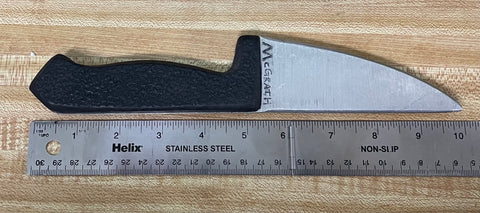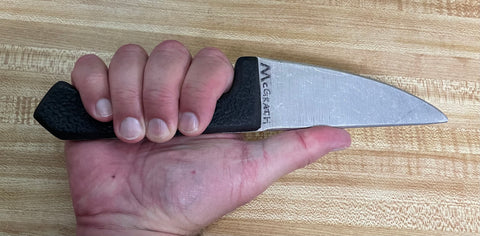SMALL BLADES FOR BIG HANDS

I often get asked for recommendations of knives for self-defense use.
This is usually easy to do, once I get the answers to these two questions:
1. What is legal for you in your area?
2. What will you be using the knife for in your daily activities, when it is not used for self defense purposes? (Which we can usually assume is the vast majority of the time. * See note 1 for an exception on this.)
The one parameter that would often make this choice difficult, is when I am asked to recommend a fixed blade for self defense that must have a blade of less than 4 inches (or 10 cm). The problem here is that most fixed blade knives with sub 4” blades have correspondingly small handles. When you have large hands, this can be a problem.
Let me share my experience with this issue. As a young man I stood 6’ 1" in height (185.42 cm); which is relatively tall, but certainly not a giant. I could not easily palm a basketball like most pro basketball player can and considered my hands to be of normal size for someone of my frame. But many knife companies seem to think I have unusually large hands (or at least, the handles on their knives are built for guys with “average” size hands).
The choice of handle size on production knives is probably due to cost (larger handles equals higher cost of materials), but perhaps it is also because of the designers designing handles to fit their own hands and their hands are simply smaller than mine. Both where a knife is designed and who designed it may be a factor here. The average size of people are not the same all over the world and how much hard work you do with your hands will play a part as well, as many jobs require more “head work” than “hand work” these days. For my dad and the other fathers in the neighborhood I grew up in, ( with lots of carpenters, mechanics and others who worked with their hands for a living ) wide, thick and strong hands were the norm.
Most of the martial artists I know who started when young have the same kind of hands*, as do weightlifters and guys who grew up playing baseball or other sports that use a stick or club. Most of the blade smiths I’ve met who forge knives with a hammer and anvil have the same strong, thick and wide hands.
(*Both my Filipino and Indonesian martial arts instructors, although much shorter than I was, had hands that were as wide and thick as mine are now, even if their hands were not as long). PHOTO: my Filipino instructor Leo Gaje (facing camera) and my Indonesian instructor Eddie Jafri (back to camera). Notice the hand to wrist ratio of each man.

BIG HANDS NEED BIG HANDLES
So, let’s look at what’s needed in a knife handle for us guys with larger than average hands.
For a knife handle to be comfortable to use, you need to take two measurements.
One is the length of your hand. This is to measure the diameter needed for the handle.

From the end of my wrist to the tip of my middle finger, my hand measures eight inches in length (20.32cm). That seems to be about average for a guy my height.
Next comes width. You can measure the width of your hand for our purposes by taking hold of a ruler in a reasonably firm grip and read how much length you need for a comfortable grip on a knife handle. Give yourself a bit extra on each end to allow for different grips, as a fencers grip will take more room than a hammer grip. Asymmetrical elements, such as finger grooves, will also make a difference in how a handle can be best held in a secure grip.

Measured this way, a comfortable knife handle for me for a full grip is a minimum of five inches in length (12.7cm).
Many knife manufacturers seem to only calculate the width the fingers need in the grip area. For them, 4 inches (10.16cm) is plenty of room for my hand. However, our hands are more than just our four fingers.

Here is an aluminum trainer I made for myself back in the 1990s.

If you look at the area gripped by just the four fingers, it looks like I have lots of extra handle that I don't need.

However, the more surface area of the palm and thumb in contact with the handle, the more secure your grip will be for self defense use.

Notice how much area the back of my hand occupies on the handle. This is important to control torque during self defense use.

FOLDERS VS FIXED BLADES

Handle length is one area where folders often have an advantage over fixed blades, especially when we are discussing blades in the 3 to 4 inch range. Notice in the photo above how the folders have a bit more handle length than the fixed blade has, (although total length doesn’t always equal usable length. See note 2.)

From LT to RT: Cold Steel Drop Forged Hunter. Cold Steel Counterpoint 1. Mora Robust. Cold Steel Master Hunter.

Here are three knives with blades of 4 inches or less; plus my Cold Steel Master Hunter, with its 4.5" blade The later is shown for comparison, as this handle really fits my hand well. Let’s look at some photos showing each of these in my hand. (The Counterpoint 1, a folder, is there as another knife that meets my minimum size requirements for a good handle.)

Here is the Cold Steel Drop Forged Hunter.
Specs:
Weight: 7.1oz
Blade Thickness: 5mm
Blade Length: 4"
Blade Steel: Drop Forged 52100 High Carbon
Handle Length: 4-5/8"
Overall Length: 8-5/8"
Additional Features: Secure-Ex® Sheath

Here is the Cold Steel Counterpoint 1
Specs:
Weight: 4.7oz
Blade Thickness: 3.5mm
Blade Length: 4in
Blade Steel: Japanese AUS10A
Handle Length/Material: 5in Griv-Ex™
Overall Length: 9in
Additional Features: Ambidextrous Pocket / Belt Clip

Here is the Mora Robust Pro.
Specs:
Overall Length:8.25" 224 mm
Blade Length:3.625" 91 mm
Blade Thickness:0.13" 3,2 mm
Blade Material:High Carbon Steel
Blade Style:Clip Point
Finish:Satin
Edge Type:Plain
Handle Length:4.625" 11.74cm
Handle Thickness:0.86" 21.84mm
Handle Material:Rubber
Color:Gray
Weight:3.56 oz. 133,4 g
Sheath:Polymer

The Cold Steel Master Hunter.
This is the older version with Carbon V steel, but I think the newer versions have the same size handle. Pekiti-Tirsia practitioners will notice that I am gripping the fixed blade knives with the edge facing out. This gives a more secure grip with the single quillion guard (especially those made of rubber.)
I find that the older I get, the more I prioritize security over versatility. Therefore, I would rather have confidence that my hand will not slide down onto the blade during a thrust, rather than have the ability to cut an opponent's arm when countering his disarming attempt.
Current specs:Weight: 6.4oz
Blade Thickness: 3/16"
Blade Length: 4-1/2"
Blade Steel: American CPM 3V High Carbon w/ Stonewashed Finish
Handle Length/Material: 4-3/4" Kray-Ex™
Overall Length: 9-1/4"
Additional Features: Secure-Ex® Sheath
To sum up: when you are choosing a knife for self defense purposes, you need to look at the handle, as well as the blade, to see if it meets your needs.
Train Hard, but Train Smart,
Tuhon Bill McGrath
NOTES:
1. One of the exceptions to the general rule that most will use a knife for non-self defense purposes the majority of the time is law enforcement. Back in the 80’s I had police students who were doing undercover drug buys and could not carry a firearm. A cheap knife that a junkie might have was the only defensive tool they could get away with carrying if searched by a dealer. Under those circumstances, if they used a knife the odds were high that it would be in a serious self defense situation.
As uniformed officers have made the transition from folding knife to fixed blade knife as their weapon retention tool, that fixed blade (whether straight, or push dagger type) has come to be the second blade they have on them and is carried as a dedicated self-defense weapon. Its sole purpose is to prevent a criminal from taking the officer’s firearm and murdering him or her with it.
2. I recently sold a large version of the Cold Steel Voyager I had because the handle did not fit my hand. The specs listed the handle as being 5.5 inches in length, but that is overall length. The actual grip area was probably an inch smaller than that due to the angle of the handle. Contrast the Voyager handle with that of the handle on the Recon 1, ( also from Cold Steel. ) Both knives have blades of four inches, but I found the handle on the Recon 1 fit my hand much more comfortably.

COLD STEEL LARGE VOYAGER


COLD STEEL RECON 1

I will be lecturing on the subject of knife handle design for self defense uses at the 2023 Ashokan Bladesmith's Seminar, in Olivebridge, NY on Sept 16th.
For info on this event, visit: https://ashokanknifeseminar.weebly.com/
NOTE: The small white box in the upper left of the Ashokan Home page is the MENU button for navigation around the website.

